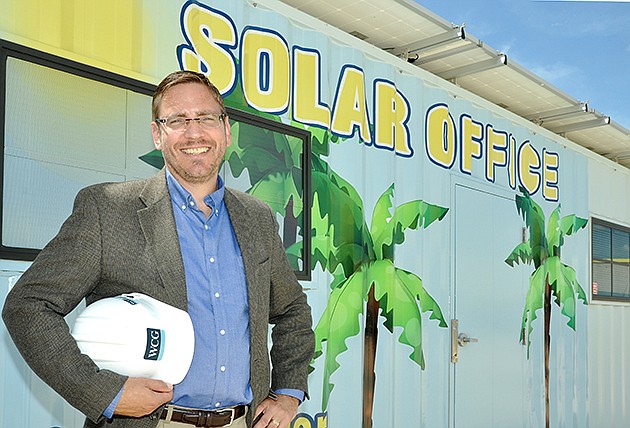Fred Edman's construction trailer produces more power than it consumes.
The trailer gets a credit from the power company because its solar panels feed excess power back into the Florida Power & Light grid, a process called net metering in utility lingo.
“This is the first temporary construction trailer that FPL has ever done net metering on,” says Edman, president and CEO of Wright Construction Group in Fort Myers.
Edman is a fan of solar energy and planned to convert his headquarters to solar energy. But when the recession began he set those plans aside. “Solar power still doesn't make economic sense,” says Edman.
But that doesn't mean it's impossible. Edman says he's been tinkering with solar for a long time, including building a prototype trailer years ago. “I enjoy the techie side of it,” he says.
“We had this idea in 2007 and 2008.”
The trailer cost Edman $37,000, he estimates. That compares with a typical construction trailer that costs $25,000 or leasing one that costs $250 a month.
So when Wright recently won the job to construct new buildings at the Florida Gulf Coast University Innovation Hub that will house a renewable energy program, he decided to dust off the plans for the trailer. “We did this because of our relationship with FGCU,” Edman says, noting the improving economy helped, too.
Edman bought a 40-foot used shipping container for $3,000 from Tropic Trailer in Fort Myers. “We cut the doors and windows,” he says.
One benefit of using a shipping container is that you don't need a trailer permit because it has no wheels, he says, and you can transport it easily on a flatbed truck. “There's a whole secondary market for used shipping containers,” Edman says.
Edman also spent about $12,000 for 21 solar panels and devices to measure their output. “We bought those from a wholesale supplier online,” Edman says.
The solar-panel installation wasn't difficult. “My carpenter installed them and he'd never done it before,” Edman says.
Wright craftsmen wrapped insulation in the walls and ceilings, installed laminated glass that is energy efficient, added power-saving LED lights and installed a high-efficiency window air-conditioning unit called a “mini split” that has a condenser outside. There's even a specially designed toilet that's raised off the floor for flushing ease. There's room on the side of the trailer in the future to install batteries that the panels can charge. “This is all out of my pocket,” Edman smiles.
But now the $100-a-month power bill for a trailer is gone.And there's also the credit for the extra energy the trailer gives to the power company. “To date, we've produced 2.7 megawatts of energy,” he says. That's roughly equivalent energy to powering about 450 homes.
What's more, the container-turned-trailer can serve as a cool base of operations in case a storm knocks out the power. “The original concept was to have this trailer as a standalone system,” Edman says.
Indeed, the trailer could be one of the few buildings with power after a hurricane. “You can sleep very comfortably in here,” Edman chuckles.
Follow Jean Gruss on Twitter @JeanGruss






